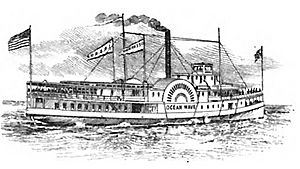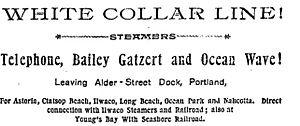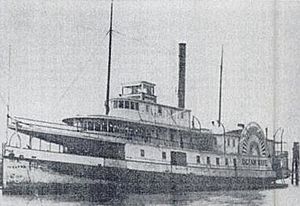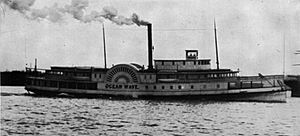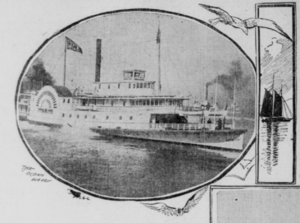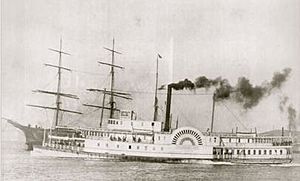Ocean Wave (sidewheeler) facts for kids
class="infobox " style="float: right; clear: right; width: 315px; border-spacing: 2px; text-align: left; font-size: 90%;"
| colspan="2" style="text-align: center; font-size: 90%; line-height: 1.5em;" | 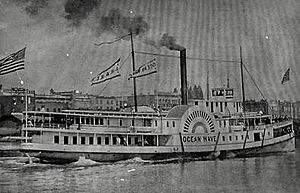
|}
The Ocean Wave was a steamboat that traveled on different waters over its lifetime. It operated from 1891 to 1897 on the Columbia River. From 1897 to 1899, it sailed on Puget Sound. Finally, from 1899 to 1911, it worked as a ferry on San Francisco Bay.
Ocean Wave is perhaps best known for carrying summer vacationers. These travelers went from Portland, Oregon, to beach resorts near Ilwaco, Washington. This happened during its time on the Columbia River. The vessel is also famous for being the first ferry used by the Atchison, Topeka and Santa Fe Railway.
Contents
- Building the Ocean Wave
- Boat Details and Features
- Working on the Columbia River
- Ownership Changes
- Moving to Puget Sound
- Bought by Santa Fe Railroad
- Moving to San Francisco Bay
- Changing the Ocean Wave
- Ferry Service
- Accidents and Incidents
| History | |
|---|---|
| Name | Ocean Wave |
| Owner | Ilwaco Rwy & Navig. Co., others later. |
| Builder | J.H. Steffen |
| Cost | $75,000 |
Building the Ocean Wave
The Ocean Wave was built in Portland, Oregon. A builder named J.H. Steffen constructed it. It was made for the Ilwaco Railway and Navigation Company.
Ocean Wave was a side-wheeler steamboat. This means it had large paddle wheels on its sides. The famous steamboat expert, Jacob Kamm, designed it. He was a wealthy businessman with lots of experience.
In early July 1891, Jacob Kamm and his son, Charles T. Kamm, worked hard to finish the new steamer. They wanted the boat to be ready by July 15, 1891. This was because low water in the river might stop the usual steamer, the T.J. Potter, from reaching Ilwaco on time.
On July 15, 1891, the Ocean Wave was launched. It cost $70,000 to build. People said it looked a lot like the T.J. Potter. The new steamer would connect with the Ilwaco trains. It would also compete with another boat on the Portland-Ilwaco route.
Boat Details and Features
When it was finished in 1891, the Ocean Wave was 180 ft (54.86 m) long. It had a width (beam) of 29 ft (8.84 m). The depth of its hold was 9.0 ft (2.74 m).
These measurements were for the main body of the boat, called the hull. The deck and cabin structure (called the "house") were wider. The house was 56 feet wide at its widest point. This meant it hung over the hull by 8 feet on each side. The total length of the vessel was reported to be 203 feet.
The Ocean Wave was quite large. Its total size was 724.40 gross tons and 507.34 net tons. Its official registration number was 155207.
The boat had two steam engines. Each engine had a cylinder that was 18 inches wide. The piston moved 84 inches. James Rees and Co. from Pittsburgh, Pennsylvania, made these engines. They were designed to produce 190 horsepower. This power turned the side wheels at 22 to 25 rotations per minute.
The side wheels themselves were 24 ft (7.32 m) across. The planks on the wheels that pushed through the water were called "buckets." These buckets were 10 ft (3.05 m) long. The steam engines were expected to make the boat travel at 18 miles per hour.
The Ocean Wave cost $75,000 to build. It had rooms for 115 passengers. There were also beds for 75 more people.
Working on the Columbia River
The first pilot of Ocean Wave was Captain Lester A. Bailey. He had previously commanded another large side-wheeler, the Olympian. Others who worked on Ocean Wave on the Ilwaco route included Charles T. Kamm as the master (captain) and Joseph Hayes as the chief engineer.
In 1889, the Ilwaco Railway and Navigation Company (IR&N) built a narrow gauge railroad. This railroad was on the Long Beach Peninsula, also known as the "North Beach." The company relied a lot on summer vacationers. These visitors came from the Portland area and other parts of Oregon.
The Ocean Wave was built to help carry these vacationers. It took them to the company's dock at Ilwaco, Washington. This dock was in Baker's Bay, near Cape Disappointment. The water there was shallow. Steamboats could not get close to the dock if the tide was too low. Because the trains needed to arrive at the dock at the same time as the steamers, the IR&N became known as the "railroad that ran by the tide."
Starting in 1891, Ocean Wave made three trips a week. It traveled from Portland to Astoria and Ilwaco. One historian described how it might have looked when the steamer met the train at Ilwaco:
Just in time for high tide at Ilwaco, a pompous little train rattled in from Nahcotta and waited at the wharf; then, from across the bay would come the steamer, a neat side-wheeler such as the Ocean Wave, and tie up at the dock. Passengers rushed ashore to get good seats in the narrow coaches, while freight and baggage from the boat was tumbled on the dock. Quickly, before an ebbing tide could ground it, the boat hurried off, and the train whistled shrilly and clattered away with its load of passengers.
The steamer was also used for special trips. On Saturday, August 15, 1891, the Ocean Wave was rented for a trip by a military group. Fireworks were set off when the boat left the Taylor Street dock in Portland at 9:00 pm. About 300 people were on board. A band played music as thousands of people watched the boat leave. Ocean Wave arrived at Astoria, Oregon, at 9:00 a.m. the next day. It dropped off some passengers, then went to Ilwaco. There, the steamer met the narrow gauge train at the dock.
On June 30, 1896, Ocean Wave arrived with the first group of vacationers for the summer. On the same day, the Oregon Railway and Navigation Company and the White Collar Line made an agreement. They would have two steamers, Ocean Wave and T. J. Potter, running twice daily between Astoria and Portland. A train track between Portland and Astoria was being built. Passengers for Gearhart and Seaside, Oregon would get off at Flavel. The roundtrip ticket from Portland to Ilwaco cost $3.50 during the 1896 summer season.
Ownership Changes
In July 1895, the leaders of the Ilwaco Railway and Navigation Company (IR&N) decided to rent the Ocean Wave. They rented it to the Columbia River and Puget Sound Transportation Company. This company was also known as the White Collar Line. At that time, the White Collar Line had two fast sternwheelers on the Columbia River: the Telephone and the Bailey Gatzert.
One of the IR&N directors, Jacob Kamm, did not agree with this decision. He placed a legal claim (called a "lien") on Ocean Wave for $17,851. This was for services his company, Vancouver Transportation Company, had provided. Kamm and Louis A. Loomis, another director, had a disagreement. It was said that Ocean Wave, designed by Kamm, was slower than Loomis wanted.
If the lien stayed, Ocean Wave would be stuck for the whole summer. This was when the boat made the most money. Kamm said if the Ocean Wave was released, he would use his own steamboats, Lurline and Undine, to compete. People thought this would cause a price war among the steamboats.
The problem was solved soon after. Louis A. Loomis, who started IR&N, went to San Francisco to get a loan of $85,000. He needed over $64,000 to pay off Jacob Kamm's claims. Loomis believed no one in Oregon would lend him the money. So, he went to San Francisco. It was rumored he got the money from the Morgan Oyster Company. They also owned a lot of shares in the IR&N.
With the loan money, Loomis paid Kamm. The legal claim was removed. Then, the Ocean Wave was rented to the White Collar Line. Ocean Wave started running on July 18, 1895. After that, it was operated and advertised as one of the White Collar Line steamboats.
Moving to Puget Sound
In December 1897, the Ocean Wave was sold. A group of people bought it to bring the steamer north to Puget Sound. Another report says the boat was rented to Cook and Co., a company in Puget Sound.
On December 7, 1897, President Loomis of the IR&N gave the Ocean Wave to Captain Charles Clancy. Captain Clancy was to take the steamer down the Columbia River and around the Olympic Peninsula to Puget Sound. One reason for the sale was that Ocean Wave was not as fast as its main competitor, the T.J. Potter. The boat was said to be not powerful enough and therefore slow.
Other reports suggest the sale was to use Ocean Wave in the shipping boom. This boom was caused by the Klondike Gold Rush. Ocean Wave did some work running from Puget Sound to Vancouver, British Columbia. Gary W. Cook was in charge.
When the Klondike market slowed down, Ocean Wave had nothing to do. In December 1898, Ocean Wave was moved from Tacoma to the Fraser River in British Columbia. It was put away for a long time. The owners were worried about keeping the boat in the "teredo-infested water" of Puget Sound. Teredos are shipworms that can damage wooden boats.
Bought by Santa Fe Railroad
By 1899, the Atchison, Topeka and Santa Fe Railway had finished its long train line. The end of the line was at Point Richmond. To complete the last part of the journey to San Francisco, the railroad needed a steamer. This boat would carry passengers across the bay.
Santa Fe had a new ferry boat being built at Union Iron Works. But it would not be ready in time. There were no other suitable local steamers. So, the railroad's traffic manager, W.A. Bissell, asked Captain John Leale to find a boat. Captain Leale worked for the Southern Pacific ferry lines.
Leale's employer, Southern Pacific, helped Santa Fe. Leale went to the Pacific Northwest to look for a boat. He first went to Portland, Oregon, then to Puget Sound. There, he met Gary W. Cook. Cook took Leale north to New Westminster, British Columbia. Cook had the Ocean Wave docked there. He offered the boat to Leale. Leale liked how strongly the vessel was built. So, he bought Ocean Wave for himself. The deal was that it had to be delivered to San Francisco. It also had to be able to start its engines and turn its wheels when it arrived.
Moving to San Francisco Bay
At 9:30 pm on Saturday, May 20, 1899, Ocean Wave left Port Angeles, Washington. It was being pulled by a strong ocean tugboat, the Richard Holyoke. Ocean Wave was not built for the open sea. So, before the trip, its sides were boarded up to protect it from waves. Water was pumped into its hull to make it more stable. The weather was good. The Holyoke arrived with the boat a day early, on May 24, 1899. Once the boat arrived and Santa Fe approved it after inspection, the railroad bought the vessel from Leale.
Changing the Ocean Wave
When Ocean Wave arrived in San Francisco, it was tied up at the Washington Street wharf. Changes had to be made to turn Ocean Wave into a ferry. Within half an hour, carpenters started working on the boat.
There were fifty staterooms (small rooms) on the main deck. There were over a hundred on the upper deck. All of these had to be removed. The upper deck was turned into one large passenger lounge (called a "saloon"). The lower deck became a freight area. The front of the boat (bow) had to be changed. This was so people could board over the front at the ferry landings in the bay.
Later, the steamer was sent to Hay and Wright's shipyard in Oakland Creek. When finished, Ocean Wave would be a "single-ender" ferry. This means it only had one end designed for loading and unloading. The San Rafael was another single-ender ferry on the bay at that time. Once in service, Ocean Wave and San Rafael would be the only single-ender ferries. All the others were "double-enders," meaning they could load from both ends.
In May 1899, it was thought the changes would take about two months. They expected to finish around August 1, 1899. However, Ocean Wave stayed in the shipyard for seven months. It was finally finished a few days before April 8, 1900.
Ferry Service
Santa Fe planned for Ocean Wave to meet its passenger trains at Point Richmond. Then, it would carry passengers and their luggage across San Francisco Bay. They would go to the Market Street ferry terminal. However, problems finishing the train line to Point Richmond stopped Ocean Wave from starting this service right away. Instead, the boat was first used to carry supplies from San Francisco to Point Richmond.
When the train line to Point Richmond was finished, Ocean Wave began its ferry service. The first trip happened on July 6, 1900. Ocean Wave left the San Francisco Ferry Building in San Francisco. It reached Point Richmond 40 minutes later. Passengers and baggage were moved to a Santa Fe train going east. This was the first train to reach Chicago entirely on Santa Fe-owned tracks. Captain John Lauritzen was the master of Ocean Wave on this trip. Ed Mahoney was the chief engineer.
The Ocean Wave's engines were not strong enough for the heavy traffic on the Point Richmond route. A new ferry, the San Pablo, was launched. When San Pablo started service in December 1900, Ocean Wave became the "relief" boat. It was used when the main ferry was being repaired or was not available. Santa Fe used both boats together for about ten years.
In May 1908, the Santa Fe Railroad arranged for Ocean Wave to take many trips around San Francisco Bay. People wanted to see the arrival of the Great White Fleet. An advertisement for these trips said:
The most satisfactory way to see the fleet is to take one of the Santa Fe excursion trips around the bay. For nearly two hours, each trip, the steamer Ocean Wave steams slowly up and down the rows of battleships, cruisers and torpedo boats, giving passengers an excellent opportunity to view the beautiful vessels from every side. Fred Harvey maintains a splendid cafe on board. There is no overcrowding. On Saturday and Sunday trips will be as follows: Leave, from Santa Fe waiting room, Ferry building, 9:00 a.m., 11:00 a.m., 1:00 p.m.; 3:00 p.m., 5:00 p.m; and 7:00; p.m. Fare $1.00. Tlckets at ferry office or 673 Market street.
Accidents and Incidents
Over the years, Ocean Wave was involved in several accidents. Some of these led to people losing their lives. These incidents happened on both the Columbia River and in San Francisco Bay.
Columbia and Willamette River Incidents
In January 1893, on the Willamette River, another steamboat called the Telephone hit an anchored ship. This happened while the Telephone was trying to pick up some hogs. The collision broke the ship's front pole. The Telephone backed away and then hit the Ocean Wave. This smashed the sternwheel on the Telephone. Damage to Ocean Wave was about $200, and to Telephone, about $500.
On Sunday night, August 18, 1895, at 11:30 pm, Ocean Wave was traveling from Ilwaco to Portland. It ran into and sank a pleasure yacht with five people on board. Two people from the yacht, John Weatherwax and Ed Wagner, drowned. The captain of Ocean Wave said the sailboat had no light on. There was also a lot of smoke, probably from the Ocean Wave, at the time. On September 25, 1895, the Steamboat Inspection Service investigated. The officers of Ocean Wave were found not to be at fault.
On September 6, 1897, a deck hand named Dell Elbon fell overboard from Ocean Wave. This happened as the steamer was passing through the Burnside Bridge. Elbon was 21 years old. His father claimed his son's death was linked to a worker dispute. He also said his son had been hit on the head before falling into the water. However, the coroner found no proof of a blow to the head.
San Francisco Bay Incidents
On November 27, 1901, a part of the engine (a cylinder head) blew out on Ocean Wave. This happened while the ferry was on its 8:00 a.m. trip. A deckhand was slightly burned by escaping steam. The engines stopped working. But a tugboat named Reliance towed Ocean Wave to and from Point Richmond that day. So, there was no delay in the ferry service. Another ferry, the Amador, took the place of Ocean Wave until repairs were done.
During a strong wind storm on February 25, 1902, Ocean Wave was blown off its ropes at Point Richmond. It drifted about half a mile into shallow water and got stuck. A tugboat and the ferry San Pablo tried to pull Ocean Wave back into deeper water, but they couldn't. Finally, a crew was put on the stranded ferry. They started a fire in the boiler to make steam. With steam power, Ocean Wave was able to get free on its own. The ferry then went to San Francisco for repairs, but the damage was not very bad.
On July 8, 1910, a carpenter named Petrus A. Erickson was thought to have fallen overboard from the Ocean Wave. Erickson was believed to have fallen into the bay from the paddle wheel housing. He had been working there when the ferry left San Francisco for Point Richmond that afternoon. Erickson's body was first reported to have been found ten days later, on July 18, 1910. It was floating under Broadway wharf No. 2. This body was supposed to be given to Erickson's brother. However, the body found on July 18 seems not to have been Erickson's. On August 19, 1910, Peter Nelson, the lighthouse keeper at Lime Point Lighthouse, found a body in the water. Based on the clothing, which had been in the water for a month or more, the coroner thought the body might be Erickson's.
Later Years
By 1911, Ocean Wave could not compete with newer and more powerful ferries. These newer ferries had two ends for loading, making them faster. The ferry was stored at Antioch, California. It was sold back to Captain Leale, who planned to break it apart for scrap.
However, when World War I started, there was a high demand for ships. Ocean Wave was sold to the United States Shipping Board. They used the vessel for about three and a half years. It became a "receiving ship" to house new recruits. These recruits were trained to be merchant sailors. The boat's engines were removed to make more space for the recruits. In the 1920s, the boat was sold again to be used as a floating restaurant. Over time, the boat slowly fell apart. According to another source, the boat was burned in 1934. This happened on the mud flats of southern San Francisco Bay, near San Mateo.
Images for kids


